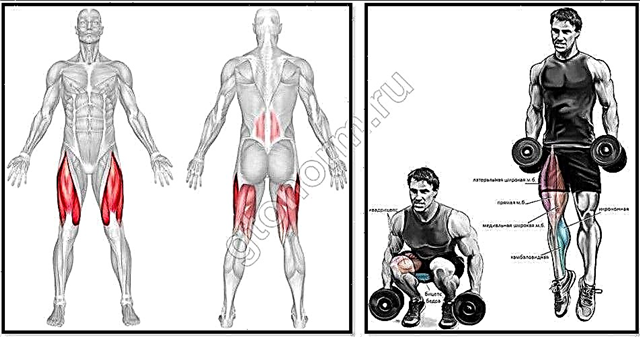The pull-up on the bar is an exercise that perfectly develops the broadest muscles of the back. Like all vertical rows, especially those performed with a wide grip, pull-ups on the bar predominantly increase the volume of our upper back in width, which creates a pronounced athletic silhouette for the athlete. Despite the prevalence all over the world and the seeming technical simplicity, this exercise is not given to everyone. The process of its implementation is not without its pitfalls, which will be discussed today in this article.
What muscles do pull-ups work?
First, let's figure out which muscles work when pulling up on the bar. This exercise loads almost the entire array of back muscles, namely the latissimus, rhomboid, trapezius and subscapularis muscles. Also, part of the load falls on the posterior bundles of the deltoid muscles, biceps of the arms, forearms, abdominal muscles and neck.
In addition, the load also falls on many small stabilizing muscles and ligaments that are responsible for our grip strength. It is for this reason that pull-ups and hanging on the bar are included in the mandatory part of the training program of any armwrestler, powerlifter, combatant or crossfitter.


The benefits of exercise
By doing regular pull-ups on the bar, you will load a huge amount of core muscles, improve posture, and strengthen your grip. In addition, the exercise involves hanging in a stretched state at the lowest point of the amplitude. This creates an excellent decompression of the vertebrae in the cervical and thoracic spine and serves as an excellent prevention of diseases of the musculoskeletal system.
Lingering for a few seconds at the lowest point, you remove hypertonicity from the extensors of the spine and stretch the muscle fascia. Due to this, over time, the stoop disappears, the pressure between the vertebrae decreases and the mobility of the neck and shoulders improves.
Types of pull-ups on the bar
There are several types of bar pull-ups. In many ways, the technique for performing them is similar, but, nevertheless, there are some differences.
High bar pull-up
The most common is a full range high bar pull-up. But not all people who have recently come to sports find this exercise easy. Affected by poor stretching of all ligaments and muscle fascia, low back muscle tone, weak grip and hypertonicity of the lower back muscles, accumulated over the years of office work and a sedentary lifestyle. Therefore, you should first master one simpler way to pull yourself up: pull-ups from the hang while lying on a low bar.

Low bar pull-up
Low bar pull-ups are an easy way to master the correct pull-up technique. To complete it, we need a horizontal bar with the ability to adjust the height or any other similar equipment (for example, TRX-loops or an Olympic bar and squat racks). Fix it at about chest level, bring your legs slightly forward, they should be slightly bent at the knees. The angle of inclination of the body should be approximately 45 degrees, we try to keep our back straight all the time, our gaze is directed forward. The more you push your legs forward, the longer the range of motion will be and the more load the latissimus dorsi will receive.
When doing pull-ups while lying on a low bar, try to work at the fullest possible amplitude, touching the bar with your chest and statically tensing your lats at the top of the amplitude. In the negative phase of the movement, try to descend as slowly as possible - this will load your back muscles even more and your strength will increase.
When you have perfectly mastered the pull-up technique from the hang while lying on the bar, start trying to perform pull-ups on the high bar. It's okay if the first few times you don't get much success. The main thing is to try to do a little more with each workout than it turned out on the next, then progress will not take long.

Pulling up with different grip widths
We recommend starting with a grip about shoulder-width apart - this will make it easier for you to feel the contraction and stretching of the broadest muscles of the back, but then you can vary the width of the grip from very narrow to wider than shoulder level. This multi-angle loading allows you to work all the muscles in your torso. The narrower the grip, the more the biceps and the lower part of the broadest muscles are involved in the work, the wider, the more the back deltas and trapezius muscles work.



Pull-up technique on the bar
- Starting position: hang on the bar, put your hands slightly wider than your shoulders. The back should be completely straight, the chin slightly raised. Hold the bar with a closed grip. An open grip will not allow you to be in a vertical hang position for a long time, without overloading the carpal ligaments.
- Begin hanging pull-ups on a high bar. We make a pulling movement upward, while exhaling at the same time. The movement should be carried out by the movement of the blades. Do not try to pull yourself up with the strength of the biceps, since the latissimus dorsi is a much stronger muscle group. The same applies to various jerking movements of the pelvis and legs - such cheating is not allowed here. Use the wrist straps to maximize your back muscles. This will take most of the load off your biceps and forearms. Try to focus on the position of your elbows. You have to "push" them down as you lift the body so the load on the broadest muscles of the back will be maximum.
- The movement should be performed in full amplitude. At the top, the chin should be above the level of the horizontal bar, and the elbows should practically be pressed against the body.
- Smoothly lower yourself down while inhaling. At the lowest point, fully straighten your arms and relax your back muscles. pause for one second, then do another repetition.
How to improve your personal result?
Below is a short series of tips and practical recommendations, taking into account, you can identify your weak points in pull-ups, draw appropriate conclusions for yourself and conquer new sports heights.
Strengthening the hands and forearms
Strengthen your hands and forearms with other exercises. A large number of repetitions in pull-ups on the bar is impossible without a strong grip and hardy forearms. Do the following exercises to improve your performance: hanging on a horizontal bar (with additional weights or with extenders), pull-ups on towels, climbing a rope without legs, squeezing the expander, and various static-dynamic exercises that strengthen your ligaments and tendons. This item especially applies to those who have suffered injuries to the ulnar or carpal ligaments. Without proper reinforcement work, you risk causing recurrence of the injury, as the ligaments may not be ready to perform serious strength work.
Additionally, strengthen your back and arm muscles. If you've already gained decent muscle mass with other free-weight exercises, getting the number of pull-ups to 20-25 pull-ups in one set shouldn't be too difficult.
Purity of execution technique
Minimize cheating in your movements. Do not deceive yourself: from the fact that you performed the last few repetitions, connecting your lower back and legs to work, you will not become stronger, and the number of technically correct pull-ups in one approach will not move off the ground. In addition, you cannot be 100% sure that this "dirty" way of doing the exercise will not lead you to injury and loss of performance.
To learn to pull up cleanly and without jerking, doing a pull-up along a wall or other fixed vertical surface is a good option. You will need a smooth, low wall or door: hang on top of it with your fingertips and lean against it as much as possible with your chest, belly, and front of your thighs. The movement is further complicated by the frictional force between your body and the wall. The work is more isolated, with almost no cheating.
Variety of execution techniques
Variety is the key to consistent training progress. Perform pull-ups in as many variations as possible: wide or narrow grip, direct or reverse, with and without additional weights. Due to such complex work, you will strengthen the entire array of back muscles, as well as increase your strength endurance.
Perform hanging pull-ups on the bar in a variety of styles. From time to time it is worth adding variety to the training process and pulling up not only in the classic style, but also in a more "pump" version, due to the isolated work of the lats of the back. The athlete does not need to try to reach as high as possible and fully straighten at the bottom point, working in such a limited amplitude, you do not let the back muscles relax for a second, which significantly increases their strength potential and the ability to work in a wide range of repetitions.
Crossfit complexes with pull-ups
| Infernal Duo | Perform 1 to 10 repetitions of burpees and pull-ups on the "ladder" principle. Immediately after that, do the reverse "ladder", dropping from 10 to 1 repetition. |
| Amatika | Perform 15 classic deadlifts, 12 floor polishers with a barbell, 9 box jumps, 6 pull-ups on the bar and 3 power grabs of the bar to the chest from the hang. Only 5 rounds. |
| Hurricane | Run 2K, 25 pull-ups on the bar, 25 push-ups from the floor, 25 push-ups on the uneven bars, 25 socks to the bar, 25 bodyweight squats. Only 5 rounds. |
| Kit-kat | Perform 60 pull-ups on the bar, 60 sit-ups, 15 jerks of the bar, 30 kettlebell swings with both hands, 50 push-ups and a 2K run. There are 3 rounds in total. |









